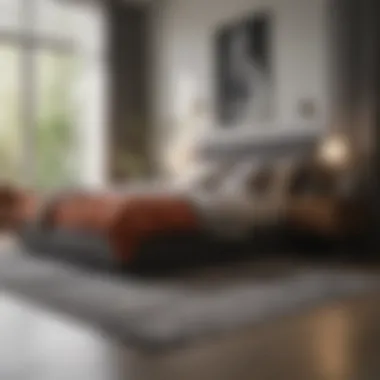Strategic Bedroom Rug Placement for Elegance and Comfort


Intro
Selecting the right placement for bedroom rugs can greatly enhance your living space. It is more than just aesthetics; careful rug placement can define areas and provide comfort underfoot. Bedrooms are personal sanctuaries where we spend a significant amount of time. The styles and key considerations for rug placement can contribute immensely to the overall ambiance. This guide aims to clarify the various factors you should consider when choosing where to place rugs in your bedroom.
Trending Styles
Modern Minimalism
In modern minimalism, simplicity reigns supreme. A well-placed rug can serve as an anchor to a room, providing warmth without overwhelming the decor. Minimalist styles prefer solid colors or subtle patterns that complement a neutral palette. For this type of bedroom, consider a low-pile rug that does not draw too much attention but adds a layer of comfort.
Cozy Rustic
Cozy rustic interiors favor warmth and charm. When considering rugs for a rustic bedroom, look for materials that highlight natural fibers, like jute or wool. A handwoven rug can add textures that soften the overall look. Placing a larger rug under the bed, extending beyond the nightstands, enhances the space. This creates an inviting atmosphere that beckons relaxation.
Color Palettes
Calming Neutrals
Calming neutral colors, such as beiges, creams, and soft grays, can create a serene bedroom environment. A neutral rug can act as a backdrop for bolder decor choices. By using a neutral rug, you allow flexibility in maintaining a tranquil vibe.
Bold Accents
If you prefer striking designs, go for bold accent rugs. These rugs can serve as statement pieces, adding personality to your room. Consider colors like navy blue or deep burgundy paired with complementary bedding. This vibrant approach can inspire positive energy in the space.
Remember: The placement can be just as important as the color. A well-placed rug can beautifully frame your bed or seating area.
Factors to Consider
When you decide where to put your rug, various factors come into play.
- Size: Measure your space. A rug should fit comfortably under your bed and extend beyond it.
- Material: Choose materials that match your lifestyle. Consider low-maintenance options if you have pets or children.
- Functionality: Think about how the rug will be used. Is it for warmth or design? This can influence its placement.
- Aesthetic: Aim for harmony between the rug and other elements of the room.
This guide offers insights that will enable you to make informed choices about bedroom rugs. By understanding the trends, colors, and factors involved in rug placement, you can enhance your space's comfort and style effectively.
Understanding Bedroom Rug Placement
In any bedroom, the arrangement of rugs can significantly impact both functionality and aesthetic appeal. Understanding where to position bedroom rugs is crucial in creating a cohesive and comfortable atmosphere. Rugs not only serve a practical purpose but also enhance the overall design of the space, providing warmth and style. Their placement can delineate areas, unify colors, and create a welcoming ambiance.
Purpose of a Bedroom Rug
The primary purpose of a bedroom rug is to add comfort and warmth underfoot. Stepping onto a soft rug can enhance the tactile experience in the bedroom. In colder climates, rugs act as insulators, making the space feel cozy. Beyond comfort, rugs can also serve as decorative elements that contribute to the room's aesthetic.
Moreover, rugs can define spaces within larger bedrooms. For example, placing a rug under a seating area can distinguish that part of the room, creating a sense of separation and purpose. Rugs can complement various decor styles, from modern minimalism to traditional elegance, bridging the gap between elements and tying together themes.
Psychological Impact of Rugs
Rug placement can also influence how we feel in a bedroom. Subconsciously, textures, colors, and patterns can evoke emotions. A plush, soft rug might evoke a sense of calm and relaxation, while a vibrant pattern may stimulate energy and creativity. The choice of a rug can contribute significantly to a person’s mood within their personal space.
Creating a harmonious environment goes beyond aesthetics; it involves psychological elements that affect well-being. The way a space feels is intrinsically linked to how we interact with it. Therefore, selecting the right rug can play a vital role in creating restful surroundings conducive to sleep and relaxation.
Material Considerations
When choosing a bedroom rug, material plays a critical role in functionality and maintenance. Rugs are available in various materials, each offering distinct qualities. For instance, wool rugs are known for their durability and natural stain resistance, making them an excellent choice for bedrooms.
Synthetic materials like nylon and polyester often come with lower price points and easy maintenance. However, these materials may lack the warmth provided by natural fibers. The choice ultimately depends on personal preferences and practical considerations.
It's also essential to consider how the material interacts with the home's existing decor. Lighter materials may reflect light and make a room feel airy, while darker options can add depth and intimacy. Ideally, the rug should complement the overall design elements, including color schemes, textures, and furniture style.


Factors to Consider for Placement
When it comes to placing rugs in a bedroom, thoughtful considerations are crucial. The right placement serves not just aesthetic purposes but also functional roles. In this section, we will explore three primary factors: room size and shape, existing furniture arrangement, and rug size and proportions. Understanding these elements can optimize rug placements and enhance both the utility and beauty of the space.
Room Size and Shape
The dimensions and layout of the room significantly influence rug placement. A large bedroom can accommodate larger rugs, whereas smaller spaces may benefit from modest sizes.
Consider the shape of the room as well. Long and narrow layouts may require runners or elongated rugs that guide the eye along the length, while square rooms allow for larger area rugs that create comfortable zones. A well-chosen rug can visually balance the room's proportions, making it feel more harmonious.
Existing Furniture Arrangement
Before deciding where to position a rug, analyze how the furniture is placed within the bedroom. The arrangement of beds, dressers, and other furnishings will dictate the optimal rug placement. Ideally, a rug should anchor the space, grouping furniture elements together.
For instance, if a bed is off-center, a rug may need to be adjusted to align with bedside tables. This creates a unified look. It is essential to consider how the rug interacts with the existing design. An inconsistent or mismatched placement can disrupt the intended flow of the room, thus negatively affecting the overall atmosphere.
Rug Size and Proportions
Selecting the right rug size is fundamental. Rugs should complement the dimensions of the room and the arrangement of furniture. A small rug in a spacious bedroom may look lost, while an oversized rug can overwhelm a small room.
Here are common guidelines for rug sizes in bedrooms:
- Under the Bed: A rug should extend roughly 18 to 24 inches beyond the bed, providing sufficient coverage and comfort.
- Side Zones: For functionality, smaller rugs can be placed beside the bed. They provide warmth and definition without overwhelming the space.
- Full Coverage: In larger rooms, consider full-bed coverage for an inviting atmosphere that ties the elements together.
Choosing the right rug not only improves aesthetics but also creates comfort and warmth in your bedroom.
Common Bedroom Rug Placement Strategies
When it comes to bedroom decor, rug placement plays a significant role in establishing the room's overall look and feel. This section focuses on various strategies for placing rugs effectively within the bedroom environment. By considering these strategies, homeowners can enhance comfort, create aesthetic appeal, and maximize the functionality of their spaces.
Under the Bed Technique
Partial Rug Placement
Partial rug placement involves positioning the rug so that only part of it is underneath the bed. This technique is quite popular because it provides a balance between style and practicality. The key characteristic of this approach is its ability to define the sleeping area without overwhelming the space. Often, a smaller area rug is placed partly under the bed, leaving enough exposed floor around the edges.
This method is beneficial as it adds warmth and texture to the room while keeping a proportionate visual balance. The unique feature is its flexibility; homeowners can choose a rug size that fits their layout without making a bold statement. However, one disadvantage is that the exposed floor may still feel cold, especially in winter.
Full Bed Coverage
Full bed coverage entails laying the rug directly under the entire bed, making it a substantial focal point in the room. This technique is a popular choice because it creates a luxurious feeling and delivers full coverage underfoot. The key characteristic of this option is the visual continuity it provides, as the rug extends beyond the bed's edges.
This choice works well in larger bedrooms, as it ties in together different elements of the room. The unique feature of full coverage is the underfoot warmth it offers, making it much cozier during colder months. However, it can sometimes lead to a cramped appearance in smaller rooms, being one of its main disadvantages.
Area Rugs as a Focal Point
Creating Visual Interest
Using rugs as a focal point is an effective way to introduce color or pattern into the bedroom. This approach focuses on selecting a bold rug that complements or contrasts with existing furnishings and decor. The key characteristic of creating visual interest is its ability to draw attention and anchor the room visually.
This method is particularly beneficial as it can transform a bland room into a stylish sanctuary. Homeowners often utilize vivid colors or intricate designs to generate diversity within the space. The unique feature here is its versatility; area rugs can easily be changed out seasonally for a fresh look. However, one disadvantage might be that if not chosen carefully, it can clash with other design elements.
Zone Definition
Zone definition involves using rugs to delineate specific areas within a larger bedroom. For example, placing a rug near a reading nook or workspace can effectively separate the sleeping area from other functions. The key characteristic of this strategy is that it enhances both function and flow within the room.
This approach is especially beneficial for open-plan layouts, as it visually structures the space. It provides a sense of order within chaos. A unique feature is that homeowners can mix and match various rug styles and sizes to reflect personal taste while ensuring that each zone serves its purpose. However, the disadvantage could be in the maintenance of multiple rugs, which can become challenging over time.
Rug Placement in Odd Layouts


Utilizing Small Rugs
In bedrooms with unconventional layouts, utilizing small rugs can be an effective solution. This tactic focuses on placing smaller rugs in strategic areas like beside the bed or in corners. The key characteristic is its adaptability; small rugs can fit in spaces that larger ones cannot.
This creates opportunities to enhance aesthetic appeal without overwhelming the room's overall design. The unique feature is that small rugs can be layered together for an eclectic look, providing flexibility. A potential disadvantage is that smaller rugs might not offer sufficient comfort underfoot, which could detract from the cozy feel intended for the bedroom.
Layering Techniques
Layering rugs involves placing one rug on top of another, combining different materials and textures for a visually rich effect. This strategy works well in larger and more complex spaces where different textures can enhance the room's overall style. The key characteristic of layering is its ability to add depth and interest to a bedroom.
This technique is particularly beneficial for creating a warm, inviting environment with varied surfaces to engage the senses. A unique feature is the freedom it gives homeowners to express their personal style, combining patterns and designs. However, the disadvantage lies in its maintenance, as uneven surfaces can be more challenging to manage and clean.
Specific Zones for Rug Placement
The strategic placement of rugs within a bedroom can significantly impact the room's overall aesthetic and functionality. Specific zones for rug placement help to define areas, create comfort, and enhance visual appeal. Understanding where to position rugs can aid in achieving a well-organized bedroom layout, improving the sense of balance and harmony. Each distinct area serves its purpose while contributing to the overall ambiance of the space.
At the Foot of the Bed
Positioning a rug at the foot of the bed can create a welcoming exit point while adding a layer of warmth. This location offers practical benefits, especially in colder months when stepping out of bed on a chilly floor can be uninviting. A rug in this zone can also serve as a transition from the bedding to the rest of the room.
When selecting a rug for this area, consider sizes that complement the width of the bed without overwhelming the space. Using a rug that is around fifty inches wide works well, as it adds comfort and visual continuity. It can act as a frame for the bed and complete the look of the room.
Alongside Nightstands
Placing a rug alongside the nightstands enhances the function and feel of the bedroom. This positioning creates a cohesive look between the bed and your bedside tables. A rug drawn out from under both nightstands can catch your feet when getting in and out of bed, thus enhancing comfort.
To maximize the effect, choose a rug that extends at least twenty to twenty-four inches beyond the edges of the nightstands. This approach ensures a balanced look and establishes a defined space around your side tables. Selecting a material that is durable and soft contributes to the overall comfort, making this zone inviting and practical.
Rugs in Dressing Areas
For those with designated dressing areas, rugs play a crucial role in delineating this functional space. A rug in this area can add comfort when dressing, especially if it is an open space without a floor covering. It offers a feeling of luxury and warmth as you transition between spaces.
In a dressing area, a slightly larger rug can be used to define the space better and create a luxurious feeling. Opt for rugs that reflect your personal style—whether that is bold patterns or understated designs. Consistency in the choice of color and material can also keep the overall design harmonic, thus completing the desired aesthetic of the bedroom.
Defining specific zones for rug placement can effectively enhance both aesthetics and functionality in the bedroom. Attention to detail in these areas elevates the room's comfort and creates a more inviting atmosphere.
Matching Rugs with Bedroom Styles
Selecting the right rug for a bedroom is not only a matter of aesthetics but also one of coherence with the overall design theme. Each style of bedroom comes with its own set of characteristics that influence the choice of rugs. By matching a rug to the predominant elements of the room, homeowners can create a harmonious and inviting atmosphere. The right rug amplifies the visual narrative of the space, showcasing individual taste. Additionally, it contributes to the comfort and functionality of the room, enhancing both foot traffic and the overall ambiance.
Modern Bedrooms
Modern bedrooms are characterized by clean lines, minimalism, and a functional approach to design. When selecting rugs for this style, consider options that maintain simplicity. Large area rugs made of natural fibers, such as cotton or jute, complement the understated elegance of modern design. Neutral colors like beige, white, or grey can serve as a backdrop, allowing other elements in the room to shine.
A pop of color may also be appropriate as long as it aligns with the color palette of the space. Geometric patterns might work well too, adding visual interest without overwhelming the room's design. In this context, the rug can underscore the modern aesthetic through its sheer presence and thoughtful placement.
Traditional Bedrooms
Traditional bedrooms often evoke a sense of warmth and nostalgia. They usually feature ornate furniture, rich textures, and a variety of colors. Here, rugs should reflect the classic elements of the decor. Persian or Oriental rugs are excellent choices due to their intricate designs and deep hues. They introduce a layer of sophistication that resonates with traditional elegance.
When placing the rug, it’s advisable to position it under the bed, allowing it to extend outward. This creates a welcoming effect as it softly transitions into the room. Additionally, layering smaller rugs over larger foundation pieces can introduce depth and create a rich experience for the feet.
Eclectic Styles
Eclectic styles embrace diversity and creativity, making them exciting yet challenging when choosing a rug. Here, homeowners can experiment with various colors, patterns, and textures. A mixed-pattern rug can tie together disparate elements of the eclectic bedroom, creating a cohesive flow. Consider vintage options or hand-woven rugs that hold character and history.
The key in eclectic spaces is to ensure that the rug resonates with the overall theme without dominating the room. Placing the rug in a visible area, like the center of the space or near a seating arrangement, ensures that it can be appreciated as a statement piece, adding to the room’s unique character.
"When choosing a rug, always consider how it interacts with the existing elements in the room, as a well-placed rug can enhance the overall design and comfort."


Caring for Bedroom Rugs
Taking care of bedroom rugs is essential for maintaining their appearance, functionality, and longevity. In this section, we will discuss critical aspects of rug maintenance that benefits both homeowners and housewives. This knowledge helps enhance the comfort and style of a bedroom while ensuring that rugs remain an enduring part of the decor.
Cleaning and Maintenance Tips
Regular cleaning is paramount when it comes to caring for bedroom rugs. Dust, dirt, and stains can accumulate over time, leading to an unpleasant living environment. Here are some important tips:
- Vacuum Regularly: A weekly vacuuming helps remove surface dirt and debris. Pay special attention to the edges and areas under furniture.
- Spot Clean Stains: For spills, it’s crucial to act fast. Blot the stain with a clean cloth instead of rubbing, which can spread the stain. Use a mixture of mild detergent and water for most stains.
- Professional Cleaning: For deep cleaning, consider hiring professionals once or twice a year, especially for rugs made of delicate materials.
Important: Always follow the rug manufacturer's cleaning instructions to avoid damage.
Choosing Durable Materials
When selecting rugs, durability is a critical factor to consider. Various materials offer different levels of durability, making some more suitable for high-traffic areas while others might be better for decorative use. Here are materials to consider:
- Wool: Known for its resilience and natural stain resistance. Wool rugs tend to last longer and maintain their appearance over time.
- Nylon: This synthetic fiber is strong and easy to clean. It is ideal for households with pets and children.
- Polypropylene: This material is budget-friendly and resistant to moisture and mildew. It’s often used in indoor/outdoor rugs.
Choosing a durable rug material ensures that your investment stands the test of time, providing beauty and comfort to your bedroom.
Preventing Wear and Tear
Preventive measures are vital for extending the life of bedroom rugs. Here are some strategies:
- Use Rugs Pads: Placing a rug pad underneath helps prevent slipping, absorbs shock, and prolongs the life of the rug by reducing friction against the floor.
- Rotate Regularly: Rotating rugs every few months helps in even wear, especially in high-traffic areas. This practice prevents the formation of uneven wear patterns.
- Limit Direct Sunlight: Exposure to direct sunlight can fade colors over time. Use curtains or blinds to control light exposure, ensuring that your rugs maintain their vibrancy.
In summary, caring for bedroom rugs involves regular cleaning, choosing the right materials, and implementing preventive measures for longevity. These practices create a cleaner, more inviting space that enhances overall comfort and style.
Common Mistakes in Rug Placement
Understanding the common mistakes in rug placement is essential for creating a harmonious and functional bedroom environment. This section explores several pitfalls that homeowners frequently encounter, highlighting their impact on aesthetics and comfort. By addressing these mistakes, you can improve the overall ambiance of your bedroom while ensuring that the rugs serve their intended purpose effectively.
Ignoring Room Proportions
When selecting and placing rugs, ignoring room proportions can lead to an imbalanced design. Each room has a specific scale, and a mismatch between the rug and the dimensions of the space can create a disjointed look. For instance, a large rug in a small room can overwhelm the space, while a small rug in a large room may feel lost. To avoid this, measure the room and the rug thoroughly before making a decision. Consider these tips:
- Choose the Right Size: Ensure the rug complements the size of the room. Aim for at least the front legs of your furniture to be on the rug to create a cohesive look.
- Visual Harmony: Maintain a balance between rug size and available floor space. Evaluate how the rug will interact with the rest of the furniture and decor.
Inconsistent Style Choices
Inconsistent style choices can also detract from the look of your bedroom. Rugs are a key element that can either harmonize or clash with the room’s existing decor. For instance, placing a modern, shaggy rug in a traditionally styled room may not create the intended effect. It is important to ensure that the style of the rug aligns with the overall aesthetic of the space. Here are some points to consider:
- Style Matching: Choose a rug that complements rather than conflicts with your bedroom style. For modern spaces, sleek and geometric patterns work best, while classic styles can benefit from traditional patterns or simple designs.
- Color Coordination: Pay attention to color palettes. The colors in your rug should enhance the walls and bedding without overwhelming them.
Overlooking Functionality
Rugs are not solely decorative items; they also provide function. Overlooking the functionality of the rug can result in discomfort and practicality issues. For example, a plush rug might look appealing, but if it’s too thick, it may create a tripping hazard. To make the right choice, keep these aspects in mind:
- Purpose of the Rug: Understand how you intend to use the rug. Is it for comfort, warmth, or visual enhancement? Choose materials based on intended uses, such as soft fibers for comfort and durability for high-traffic areas.
- Maintenance Considerations: Think about cleaning and upkeep. Certain materials require more maintenance, which could become burdensome over time.
Addressing these common mistakes will enhance the aesthetic appeal and practicality of your bedroom layout, ensuring that the rugs you choose contribute positively to the overall environment.
Finale
Rug placement in the bedroom serves a dual purpose: it enhances comfort and contributes to the overall aesthetics of the room. As we have explored throughout this guide, making informed decisions regarding where to place your rugs can transform the space. Whether it’s under the bed, at the foot, or in dressing areas, each placement strategy has its unique benefits.
One key consideration is how rugs help define spaces within the bedroom. For example, a well-placed rug can create a cozy area for relaxation, while also contributing warmth and softness. This is crucial not only for the physical comfort but also for setting the psychological tone of the bedroom. Additionally, thoughtful rug placement can balance visual elements, harmonizing with existing furniture arrangements and decor styles.
Understanding the different strategies available allows homeowners to avoid common pitfalls, such as ignoring room proportions or selecting mismatched styles. It also opens up avenues to express personal style in ways that feel intentional and curated rather than haphazard.
In essence, the correct placement of rugs will yield a multitude of benefits including improved functionality and visual appeal, aiding in the overall creation of a tranquil living environment. Thus, making these considerations central will elevate the bedroom experience, transforming it into a true sanctuary.
Key Takeaways
- Rug Placement Importance: Selecting the right spot for your rug enhances both comfort and style in the bedroom.
- Defining Spaces: Rugs can help to delineate different areas, creating cozy spots for various activities.
- Visual Balance: Thoughtful placements enhance the room’s visual appeal while ensuring the decor appears cohesive.
- Avoiding Mistakes: Be mindful of room proportions and ensure that styles match to enhance overall aesthetics.
- Psychological Benefits: Rugs contribute positively to how a space feels, promoting warmth and tranquility.















